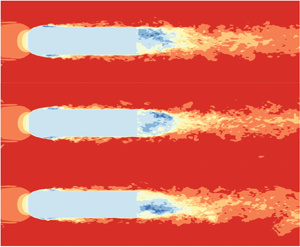Article contents
Low-order modelling of the wake dynamics of an Ahmed body
Published online by Cambridge University Press: 01 October 2021
Abstract

We investigate the large-scale signature of the random switches between two mirrored turbulent wake states of flat-backed bodies. A direct numerical simulation (DNS) of the flow around an Ahmed body at a Reynolds number ( $Re$) of 10 000 is considered. Using proper orthogonal decomposition (POD), we identify the most energetic modes of the velocity field and build a low-dimensional model based on the first six fluctuating velocity modes capturing the characteristics of the flow dynamics during and between switches. In the absence of noise, the model produces random switches with characteristic time scales in agreement with the simulation and experiments. This chaotic model suggests that random switches are triggered by the increase of the vortex shedding activity. However, the addition of noise results in a better agreement in the temporal spectra of the coefficients between the model and the simulation.
$Re$) of 10 000 is considered. Using proper orthogonal decomposition (POD), we identify the most energetic modes of the velocity field and build a low-dimensional model based on the first six fluctuating velocity modes capturing the characteristics of the flow dynamics during and between switches. In the absence of noise, the model produces random switches with characteristic time scales in agreement with the simulation and experiments. This chaotic model suggests that random switches are triggered by the increase of the vortex shedding activity. However, the addition of noise results in a better agreement in the temporal spectra of the coefficients between the model and the simulation.
JFM classification
- Type
- JFM Rapids
- Information
- Copyright
- © The Author(s), 2021. Published by Cambridge University Press
References
REFERENCES
- 10
- Cited by





